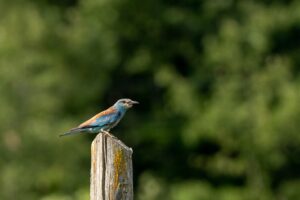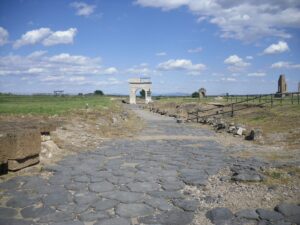Archeobirding
In addition to such famous localities as Pompeii, Herculaneum, and the temples of Agrigento, Italy is dotted with countless Etruscan, Faliscan, Greek, and Roman archeological sites where temples, roads, and houses are still visible. For many bird species, these are very appealing habitats, ecologically similar to natural areas where rocks and cliffs predominate. Ruins are often nestled into the rural landscape, which increases their value to bird and to birders, who can enjoy a cultural experience while pursuing their natural history interests at the same time.
 The Etruscan town of Vulci, for example, combines birds and history in the most impressive possible way. Eurasian hoopoes, Italian sparrows, bee-eaters, and crested larks flutter and chirp among the monuments and palaces once inhabited by the women and men whose tombs now dot the tuff hills. It is worth pondering how many generations of common nightingales have come and gone since the Roman road was first laid down, and how many blackcaps have sung their feathered hearts out since the Etruscans sought safety on this high plateau.
The Etruscan town of Vulci, for example, combines birds and history in the most impressive possible way. Eurasian hoopoes, Italian sparrows, bee-eaters, and crested larks flutter and chirp among the monuments and palaces once inhabited by the women and men whose tombs now dot the tuff hills. It is worth pondering how many generations of common nightingales have come and gone since the Roman road was first laid down, and how many blackcaps have sung their feathered hearts out since the Etruscans sought safety on this high plateau.
The necropolis of Cerveteri is a huge complex of wide avenues, monumental tombs, and ancient trees. Barn swallows nest in the tombs, and firecrests and Eurasian wrens hiss and bubble from the tall pines and lush undergrowth. Migratory and nesting birds seen here include the whinchat, collared flycatcher, zitting cisticola, and wood and Sardinian warblers.
The Via Appia was one of the most important of the Roman “long roads.” Today, the first part of the Via, just outside Rome, forms the spine of an 8,400-acre regional park, offering some of the best birding to be had in central Italy. Dotted with Roman buildings and archaeological sites, this amazing area affords a captivating opportunity to watch breeders and migrant birds against a backdrop of ancient tombs, early Christian chapels, thermal baths, and palaces. Many species nest or roost right on these historic structures, and there is nothing like the thrill of discovering a little owl perched atop the ruins of an ancient aqueduct. The Eurasian kestrel, common quail, greenfinch, corn bunting, red-backed shrike, green woodpecker, Eurasian wryneck, and skylark are just some of the species that can be observed a scant half mile from the Colosseum.
 Twenty miles north of Rome are the ruins of an ideal city, known today as Villa Adriana, commissioned by the emperor Hadrian. Combining Egyptian, Greek, and Roman styles, the three dozen surviving buildings include temples, theaters, palaces, and thermal baths, all set amid three hundred acres of woodland and open areas. A walk through this astonishing place is likely to turn up such specialties as the common cuckoo, European bee-eater, or Eurasian hoopoe, along with the usual suite of colorful tits and finches. Blue rock-thrushes can be seen on the ruins, and the site boasts one record of the spectacular rufous-tailed rock-thrush.
Twenty miles north of Rome are the ruins of an ideal city, known today as Villa Adriana, commissioned by the emperor Hadrian. Combining Egyptian, Greek, and Roman styles, the three dozen surviving buildings include temples, theaters, palaces, and thermal baths, all set amid three hundred acres of woodland and open areas. A walk through this astonishing place is likely to turn up such specialties as the common cuckoo, European bee-eater, or Eurasian hoopoe, along with the usual suite of colorful tits and finches. Blue rock-thrushes can be seen on the ruins, and the site boasts one record of the spectacular rufous-tailed rock-thrush.
Visits to these sites must be conducted by a licensed tourist guide, but of course I am allowed to share our natural history observations as we go along.
“We saw lots of coots, teals, kingfishers, flamingoes , ospreys, kestrels, spoonbills, dunlins and many more….but what makes birding so unique is that the birding is combined with visiting very ancient Etruscan and Roman archeological ruins and medieval towns” – Happy Customer from TripAdvisor
